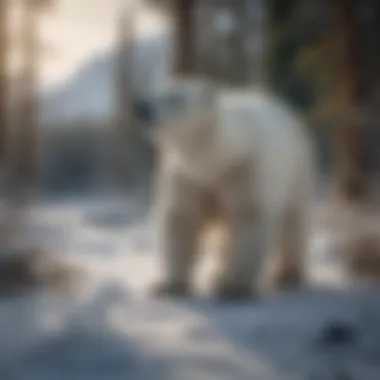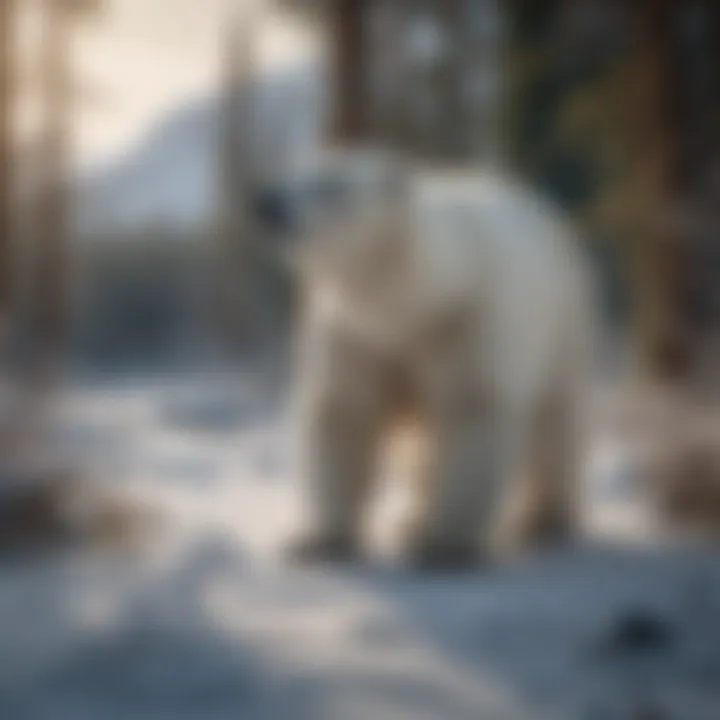The Impact of Climate Change on Animal Populations


Intro
Climate change exerts profound effects on the natural world, influencing not just weather patterns but the intricate balances within ecosystems. Animal populations are particularly vulnerable to these shifts. Understanding the cascading impacts of climate change on animals is essential for effective conservation strategies. This article will examine how climatic changes are reshaping animal behaviors, migration routes, and survival, emphasizing the urgency for informed action.
Understanding Woodland Ecosystems
Woodland ecosystems are vital components of our planet's biodiversity. They offer refuge and resources for countless animal species, making their health crucial for ecological stability and resilience.
Importance of Biodiversity in Forests
Biodiversity in forests facilitates a multitude of ecological functions. Each species, whether large or small, plays specific roles in maintaining the health of these ecosystems. For example, producers like trees provide oxygen and food, while consumers and decomposers contribute to nutrient cycling. Lost biodiversity can result in ecosystem fragility, making it imperative to understand the impacts of climate change. The decline of specific species can lead to habitat degradation, affecting broader ecological interactions.
Role of Forests in Climate Regulation
Forests play a critical role in regulating the climate. They absorb carbon dioxide, thereby mitigating greenhouse gas concentrations in the atmosphere. Additionally, forests influence local and regional weather patterns through transpiration and shading, altering humidity and temperature. With climate change, the loss of trees due to increased temperatures and extreme weather disrupts these functions, resulting in further exacerbation of climate issues.
Impacts of Climate Change on Animals
Animal populations face numerous threats stemming from climate change. These include altered habitats, disrupted food resources, and changed reproductive behaviors.
- Habitat Loss: As temperatures rise, many animals struggle to find suitable habitats. Certain species may migrate, while others face extinction if they cannot adapt.
- Food Resources: Changes in plant life and the availability of prey affects what animals can eat. Some animals may find less food, leading to starvation or reduced reproduction rates.
- Reproductive Changes: Climatic shifts can impact breeding cycles. For instance, altering seasonal cues may disrupt the timing for reproduction.
"Climate change does not only threaten individual species; it endangers entire ecosystems and their complex interrelations."
Finale
Prelude to Climate Change and Its Implications
Climate change is a dominating force shaping today's natural world. Its implications extend far beyond human experiences, directly influencing many animal species and their habitats. Understanding the context of climate change is key to addressing the critical challenges faced by wildlife. This section reveals the importance of recognizing ongoing changes in our climate and how they consequently affect animals.
Understanding Climate Change
Climate change refers to long-term alterations in temperature and weather patterns. While Earth has naturally undergone shifts over millennia, recent changes are primarily due to human activities, such as burning fossil fuels. The resulting greenhouse gases trap heat in the atmosphere, leading to global warming. As temperatures rise, various ecosystems undergo stress, which disrupts traditional habitats. Animals dependent on specific environmental conditions face increased risks, leading to shifts in populations and sometimes extinction. It is essential to appreciate how even slight changes in climate can have profound impacts on ecological balance.
- Animals find their habitats becoming unsuitable due to rising temperatures.
- Shifts in migration patterns often result from altered weather systems.
- Some species may struggle to find food or reproduce, further threatening their survival.
The Urgency of Addressing Climate Change
The urgency of addressing climate change cannot be overstated. Immediate and concerted efforts are necessary to mitigate its effects. Many animal species are already experiencing these changes, with biodiversity loss recognized as a critical concern.
"Biodiversity is not only vital for the health of ecosystems but also for the survival of all species on Earth."
Some of the most pressing issues include:
- Habitat loss: As temperatures rise, suitable environments for many species are diminishing. Animals may be forced to migrate, often leading to increased competition for resources.
- Increased diseases: Changes in climate can lead to the spread of diseases as new vectors arise, putting animal populations at further risk.
- Food shortages: Altered weather patterns also affect the availability of food, causing malnourishment and adversely affecting reproduction rates.
Overall, the implications of climate change affect not only animal populations but also the broader ecological systems they inhabit. Taking swift action is crucial to ensure a balanced interaction with our ecosystems.
Direct Effects on Animal Species
The direct effects on animal species due to climate change are significant and multifaceted. They represent critical shifts in the environmental conditions in which animals thrive. As climate change progresses, it has become clear that these direct impacts will alter the delicate balance of ecosystems. The consequences not only affect individual species but can also have ripple effects throughout entire ecosystems. Understanding these effects is crucial for developing effective conservation strategies and ensuring the survival of various animal populations.
Habitat Alteration
Climate change is driving profound changes in habitats. As temperatures rise, many ecosystems are shifting. For example, forests may migrate to higher elevations, while wetlands might expand or contract depending on precipitation changes. These alterations can lead to habitat loss for species that are unable to adapt or relocate. Aquatic habitats are particularly vulnerable, with rising sea levels threatening coastal ecosystems and altering aquatic life’s distribution.
The loss of habitat is alarming as it directly leads to decreased biodiversity. Species such as the polar bear and the orangutan face imminent threats due to these shifts in their habitats. Animals that depend on specific environmental conditions for shelter, food, and reproduction are at risk of extinction if they cannot adapt or find suitable new habitats.
Changes in Food Availability
Food availability for many animal species is being impactd directly by climate change. As plants and other primary producers react to rising temperatures and fluctuating weather patterns, the food web is disrupted. For ruminants, like deer and cows, the nutritional quality of grasses can decline in a warmer climate. Marine life also suffers as ocean temperatures rise, causing shifts in fish populations and coral reef systems.
This change can have far-reaching consequences. For predators that rely on certain prey, like the decline of krill in polar regions, finding enough food becomes more difficult. Such changes can disrupt feeding patterns and ultimately affect reproduction and population size.
Impact on Reproductive Patterns


Reproductive patterns in many species are closely tied to environmental factors such as temperature, food availability, and habitat conditions. As these factors change due to climate change, reproductive cycles may be adversely affected.
For example, some fish species spawn at different times of the year based on temperature cues, leading to mismatches between the availability of young fish and their food sources. Similarly, birds that rely on specific timing for migration and breeding face challenges; changes in weather patterns could lead to nesting at a time when food is scarce.
This phenomenon of altered reproductive timing can lead to lower survival rates for offspring. In the long run, population declines can occur, disrupting ecological balance and threatening species with extinction.
"Ecosystems are intricate networks where even small changes can lead to significant consequences. Understanding these dynamics is essential for effective conservation."
Recognizing these direct effects is vital for grasping the full consequences of climate change on wildlife. Protecting their habitats and adjusting conservation strategies to accommodate these changes will be essential for safeguarding the future of many animal species.
Alterations in Animal Behavior
The alterations in animal behavior due to climate change are crucial to understanding how various species adapt or struggle in shifting environments. Animals respond to changes in climate in diverse ways, affecting their feeding, migration, and social interactions. Any disruption in these behaviors can lead to biodiversity loss and ecological imbalances.
Feeding Behaviors
Climatic factors influence what animals eat and when they eat. For instance, rising temperatures and altered precipitation patterns may shift the availability of food resources. Herbivores, such as deer and rabbits, may find less vegetation, while predators may experience changes in their prey's prevalence. Insects, too, play a key role in pollination; thus, their own feeding habits affect plant reproduction.
"Changes in feeding behaviors can destabilize entire ecosystems. If one species adjusts its diet but another does not, the balance can collapse."
Consequently, animals may change their foraging schedules, moving to different locations in search of familiar foods. This alteration can affect birth rates and survival, as food scarcity often leads to lower reproductive success and higher mortality.
Migration Patterns
Migration is a vital behavior for countless species, particularly birds and marine animals. Climate change has triggered shifts in migratory routes, timing, and destinations. Many birds are now arriving at breeding sites earlier than usual due to warmer spring temperatures. This mismatch impacts their reproductive success due to the timing of food availability in these regions.
Moreover, marine species face similar issues. Fish are moving toward cooler waters in response to rising ocean temperatures, impacting local fisheries and ecosystems. New migration patterns can lead to conflicts between species and other ecological pressures.
Social Interactions
Social behaviors among animal groups are also impacted by climate change. As habitats are altered, many species are prompted to adjust their social structures. For example, polar bears may become more solitary as their ice habitat shrinks, limiting their ability to hunt and socialize. Similarly, elephants may alter their herd dynamics in response to food and water scarcity.
Changes in social interactions can disrupt breeding patterns and lead to stress-related behaviors. Animals might become more aggressive or retreat into isolation. Overall, these drastic shifts can contribute to weakened animal populations and enhanced vulnerability to extinction.
In summary, as climate change accelerates, understanding the alterations in behavior becomes paramount for conservation efforts. These changes form a complex web of ecological interactions that must be monitored closely to support animal populations effectively.
Physiological Effects on Animal Health
Animal health is a critical factor in the overall ecosystem's balance. As climate change continues to alter environmental conditions, physiological effects on animals are becoming more pronounced. These impacts can lead to decreased survival rates or altered reproductive success among various species. Understanding these physiological effects helps researchers and conservationists formulate strategies to mitigate risks and design effective intervention programs.
Temperature Stress
One of the most significant physiological challenges animals face is temperature stress. As average global temperatures rise, many species struggle to adapt to these new conditions. For instance, ectothermic animals, such as reptiles and amphibians, rely heavily on external temperatures to regulate their body heat. Elevated temperatures may lead to increased metabolic rates, which can exhaust energy reserves more quickly.
Moreover, prolonged exposure to extreme temperatures can result in heat stress. Symptoms include lethargy, decreased appetite, and increased susceptibility to disease. In terrestrial mammals, the risk is also present; animals like polar bears may find it increasingly difficult to regulate body temperature as ice caps melt, leading to overheating. Thus, species have to adapt or face survival challenges from temperature fluctuations.
Respiratory and Cardiovascular Issues
Climate change also brings changes in air quality, impacting the respiratory and cardiovascular systems of many animals. Increased concentrations of pollutants like carbon dioxide and particulate matter can lead to respiratory problems. For example, birds, with their sensitive respiratory systems, can experience issues that affect their ability to sing, mate, and survive.
Additionally, as temperatures rise, cardiovascular strain can occur. High heat can push animals' hearts to work harder, leading to potential failures or stress-related conditions. This physiological strain not only affects individual animals but can have ripple effects on populations, influencing their social structure and reproductive success.
Disease Vulnerability
Changes in climate result in shifts in disease patterns as warm conditions facilitate the spread of pathogens and parasites. Warmer temperatures may enable disease vectors like mosquitoes to thrive in previously inhospitable regions. As animals migrate to find suitable habitats, they may come into contact with new pathogens, leading to potential outbreaks.
Certain diseases can decimate populations, particularly in vulnerable species. For example, amphibians have been severely impacted by chytridiomycosis, exacerbated by changing climate conditions. It underlines how crucial it is to monitor emerging diseases and their interactions with climate change. Preventative measures need to be updated continually to protect animal health.
"The interplay between climate change and animal health is complex and multifaceted, requiring urgent action and adaptive management strategies."
Ecosystem Dynamics and Biodiversity Loss
Ecosystem dynamics involve the interplay of various biological and physical components within an ecosystem. The effects of climate change on these dynamics can lead to significant biodiversity loss. This is critical because ecosystems provide essential services such as clean air, water purification, and food resources. A healthy ecosystem supports various species, maintaining balance and stability. Losing biodiversity threatens these functions and diminishes nature’s resilience to environmental changes.
Shifts in Biodiversity


Biodiversity is not static. Climate change forces shifts in species distribution, altering the composition of ecosystems. For instance, rising temperatures may drive some species to migrate to cooler areas. This shift can lead to new competitive interactions, where native species may struggle against invasive species adapted to the changed environment. The loss of specific species can disrupt food webs, leading to further ecological imbalances. As different species respond uniquely to climate stressors, understanding these shifts is vital for conservation strategies.
Trophic Level Changes
Trophic levels describe the hierarchical structure of food chains in an ecosystem. Climate change can alter the productivity and presence of species at various levels, causing cascading effects throughout the ecosystem. Higher temperatures can affect primary production, impacting herbivores and, subsequently, carnivores. If key species decline or proliferate unexpectedly, it can alter population dynamics across multiple levels. A change in available resources not only affects diet but also influences behavior and reproduction in many animal groups.
Endangerment of Species
The threat of endangerment looms large for many animal species due to climate change. A changing climate can lead to habitat loss, food scarcity, and increased competition. Species with specific habitat requirements, such as polar bears or coral reefs, are particularly vulnerable. As conditions worsen, the risk of extinction rises. Conservation efforts focus on identifying at-risk species and their habitats. It is vital to take preemptive action to prevent further losses in biodiversity and to protect the complex relationships that sustain ecosystems.
Addressing climate change and its impacts on ecosystems is not just an environmental issue; it is a necessity for sustaining human life and health.
Climate Change Effects on Specific Animal Groups
Understanding the effects of climate change on specific animal groups is essential for pinpointing how environmental changes impact biodiversity and ecosystem stability. Each group, including marine life, terrestrial mammals, birds, and insects, exhibits unique vulnerabilities and responses to climate change. By dissecting these elements, we gain insights into the broader implications for conservation efforts and management strategies. It also aids in identifying critical areas needing immediate action to mitigate threats posed by climate shifts.
Marine Life
Marine ecosystems are on the front lines of climate change, grappling with rising sea temperatures, ocean acidification, and changing salinity levels. The warming waters lead to coral bleaching, which significantly affects the myriad species that depend on coral reefs for habitat and food. Fish populations, like cod and haddock, shift toward deeper, cooler waters, altering the dynamics of fishing industries and local economies.
Additionally, migratory patterns of marine species such as sea turtles and whale species are changing as they seek breeding and feeding grounds in more favorable conditions. These shifts can disrupt existing marine networks, and the consequences ripple through other species that rely on these connections for survival. Addressing these issues is crucial for maintaining the balance and health of oceanic ecosystems.
Terrestrial Mammals
Terrestrial mammals, including iconic species like polar bears and elephants, face numerous challenges as their habitats are affected by climate change. Habitat loss from deforestation and desertification directly diminishes living spaces while altering food sources. Species such as the snow leopard, adapted to cold environments, are forced to change their ranges and behavior in response to thawing conditions in their mountain habitats.
Furthermore, rising temperatures can lead to increased competition for resources. For example, different species may migrate to the same regions, leading to heightened conflicts over territory and food. The impact on reproduction is also significant, where changing environmental cues can affect breeding cycles. Understanding the nuances of these effects is vital for developing targeted conservation strategies.
Birds and Their Migration
Bird species are exceptional indicators of climate change effects due to their often well-documented migratory patterns. Alterations in temperature and food availability influence migration timing and routes. Species such as the Arctic tern, known for its long migratory routes, are experiencing shifts due to earlier springs and changing weather patterns.
As climate zones shift, some birds may find themselves mismatched with their traditional habitats, leading to potential decreases in survival rates. The loss of migratory stopover sites further hinders their ability to rest and refuel during long journeys. Recognizing the implications of these changes is critical for bird conservation programs and habitat protection initiatives.
Insects and Pollination
Insects play a pivotal role in pollination, contributing to the health of ecosystems and agriculture. However, they are vulnerable to climate change. Increased temperatures can affect insect lifecycles, leading to shifts in populations and behaviors. For instance, certain butterfly species are emerging earlier in the spring than usual, which can disrupt their synchronization with blooming plants.
The decline in bee populations due to changing climates poses a serious threat to global food security and biodiversity. Pollinator species are sensitive to temperature fluctuations and habitat alterations, making them critical subjects of study in the context of climate change. Addressing these shifts through conservation and supportive policies is the key to maintaining ecological balance.
"Insects are not just pests but are essential players in the ecosystem, especially as pollinators. Their decline highlights the urgency of addressing climate change impacts on all life forms."
Understanding the specific effects of climate change on these animal groups not only enhances our comprehension of ecological interdependencies but also strengthens our approaches to conservation and animal welfare. As we forge ahead, integrating this knowledge into policy and education remains essential for fostering a resilient environment.
Adaptive Strategies for Animal Survival
Climate change presents unprecedented challenges to animal survival. As habitats shift and environmental conditions fluctuate, species must find ways to adapt in order to thrive. Understanding adaptive strategies is essential for comprehending the mechanisms that allow animals to cope with these changes. This section explores two key areas: natural adaptations and conservation programs.
Natural Adaptations
Animals have evolved various mechanisms to adapt to their environments. These adaptations are crucial in response to climate change. For instance, some species may exhibit physical changes, such as alterations in size or coloration, which can enhance their survival.
- Behavioral Changes: Birds might change their migration patterns, timing their flights to coincide with seasonal changes. Mammals, on the other hand, could adapt their feeding behaviors, switching to new food sources that become available due to changing ecosystems.
- Physiological Adaptations: Changes in heart rates or metabolic rates can also occur in response to temperature shifts. For example, certain fish species can tolerate warmer waters by adjusting their organ functions. These adaptations are essential for maintaining homeostasis in fluctuating conditions.
- Reproductive Adjustments: Moreover, reproductive strategies may shift. Some species might breed earlier in the year to synchronize their life cycles with the availability of food resources.
Conservation Programs
While natural adaptations play a significant role, active conservation efforts are equally vital in supporting animal species facing climate change. Various conservation programs aim to enhance survival through focused interventions. These include:
- Habitat Preservation: Protecting and restoring natural habitats are critical. Initiatives that focus on preserving wetlands or forests can bolster the resilience of local wildlife.
- Species Management: In some cases, specific species may require targeted management strategies. Programs that involve breeding endangered species in captivity followed by reintroduction into their habitats can help bolster populations.
"Effective conservation strategies not only address immediate threats but also consider the long-term adaptability of species."
- Monitoring and Research: Continuous observation of wildlife populations and their behaviors provides invaluable data. Research programs track how species are responding to climate stresses and inform adjustments to existing conservation strategies.
- Community Engagement: Involving local communities in conservation efforts fosters better outcomes. Awareness and education can lead to more sustainable practices that benefit both animals and their habitats.
By combining natural adaptations with structured conservation programs, we can improve the chances of animal survival as the climate continues to change. Addressing these needs comprehensively ensures that we do not just react to the symptoms of climate change but also proactively support resilient ecosystems.


Challenges in Climate Mitigation Efforts
The issue of climate change poses significant barriers to effective mitigation efforts, especially in relation to animal populations and biodiversity. It is critical to understand these challenges as they shape the strategies that can be employed to protect vulnerable species. The complexity of the matter often stems from the interplay between environmental policies and practical funding avenues. This section dissects key challenges, highlighting policy gaps and funding shortfalls that hinder progress in combatting climate change’s impact on animals.
Policy Gaps
Policy gaps refer to the deficiencies found within existing legislation and regulations aimed at addressing climate change. Often, these gaps leave certain aspects unregulated or ineffective. For example, many countries lack comprehensive laws that specifically target the preservation of habitats crucial for particular animal species. Additionally, inconsistent international agreements create complications in collaborative efforts across borders. Because ecosystems do not adhere to national boundaries, animals such as migratory birds or marine life suffer due to a disjointed approach to climate policies.
Furthermore, regulatory frameworks may fail to take into account emerging scientific data that highlight the urgency of specific actions. A good example is the slow response to the rapid decline in certain animal populations directly linked to climate fluctuations. The absence of timely and informed policymaking can impede conservation initiatives and lead to further degradation of ecosystems. In summary:
- Inconsistent international policies hinder global animal conservation efforts.
- Lack of specific regulations for vulnerable habitats leads to species decline.
- Slow incorporation of scientific research into policy results in missed opportunities for effective intervention.
Funding Shortfalls
Funding shortfalls represent another major obstacle in the fight against climate change’s effects on animals. Conservation programs and mitigation projects require substantial financial investment. However, many initiatives struggle to secure the necessary resources. This often occurs due to competing priorities in government budgets or a general underappreciation of the long-term value of environmental conservation.
Without adequate funding, efforts such as wildlife rehabilitation, habitat restoration, and research into animal behavior are either delayed or canceled entirely. Non-governmental organizations, which often shoulder the burden of these projects, also face similar challenges, making it increasingly difficult to sustain existing programs. The financial landscape reveals the following:
- Dependence on limited government resources restricts potential conservation efforts.
- Reduction in environmental funding impacts crucial research and rehabilitation programs.
- Non-profits struggle to maintain funding for ongoing projects, limiting their effectiveness.
"To effectively conserve wildlife and their habitats, a commitment from all levels of government and society is essential. Without funding, many crucial projects risk discontinuation, further jeopardizing species already on the brink."
Understanding these challenges is imperative for developing comprehensive climate change strategies that include effective animal conservation measures. Addressing policy gaps and funding shortfalls will lead to more cohesive and sustainable efforts, ultimately ensuring that animal populations are protected in the face of ongoing climate threats.
The Role of Community and Education
Community involvement and educational initiatives are crucial elements in addressing the impacts of climate change on animals. Collective awareness fosters a greater understanding of the complex relationships between climate change, animal behavior, and conservation efforts. Without this shared knowledge, efforts to mitigate adverse effects become fragmented and less effective.
By focusing on community-driven initiatives, we create networks that empower individuals to take action. This can range from organizing local conservation projects to supporting broader policy advocacy. The involvement of the community ensures that actions taken are grounded in local knowledge and contexts, making them more relevant and impactful.
Furthermore, education plays a significant role in shaping future generations. Integrating ecology and conservation topics into educational curricula can drive long-term change. Students become more connected to their environment and understand the importance of biodiversity and wildlife protection. This connection can influence their choices and actions as adults, fostering sustainable practices in their communities.
Public Awareness Campaigns
Public awareness campaigns serve as one of the most effective means to communicate the urgency of climate change impacts on animals. These campaigns can inform the wider public about specific threats faced by various species and the ecosystems they inhabit. By utilizing both traditional and digital media, these initiatives can reach diverse demographics.
Key elements of successful public awareness campaigns include:
- Clear, scientifically accurate messaging
- Engaging visuals that highlight affected species
- Accessible information on how individuals can contribute to conservation efforts
For instance, platforms like Facebook and community outreach events can greatly amplify the reach of these messages. By informing the public and encouraging them to act, we can harness collective power for meaningful change.
"Awareness is the first step towards action. Without it, efforts to protect species can remain ineffective and underfunded."
Incorporating Ecology into Education
Incorporating ecology into educational programs is vital for fostering a generation that prioritizes environmental stewardship. This can be achieved by:
- Adding ecology-focused modules to existing curricula
- Facilitating hands-on experience through field studies and projects
- Encouraging community service related to local ecosystems
Students engaged in these activities develop a deeper understanding of ecological systems, including how climate change affects various animal populations. Exposure to real-world environmental issues can support critical thinking and problem-solving skills. Furthermore, pivotal relationships can be formed between schools and local conservation organizations, creating mutual benefits for students and wildlife protection efforts.
The End and Future Directions
Climate change presents a substantial threat to animal populations and ecosystems. It is essential to recognize the profound implications of these changes on biodiversity and survival rates. The conclusion of this article synthesizes the insights gained throughout, painting a clear picture of the ongoing crises and potential future outcomes for animal species in a rapidly changing world.
Summary of Key Findings
The key points uncovered in this article highlight the wide-ranging effects of climate change on animals.
- Habitat Alteration: Significant environmental changes lead to shifting habitats, pushing some species into increasingly constricted areas.
- Behavioral Changes: Species adapt their feeding and migration patterns in response to changing climates, impacting their ecological interactions.
- Health Impacts: Rising temperatures and altered ecosystems contribute to physiological stress and increased disease susceptibility.
- Biodiversity Loss: As ecosystems become unstable, the balance of life is disrupted, leading to reduced species variety and increasing endangerment of vulnerable populations.
Call to Action for Conservation
Addressing the multifaceted impacts of climate change necessitates immediate and strategic conservation efforts. Active engagement from all sectors of society, including researchers, policymakers, and the public, is vital. Specific measures include:
- Supporting Conservation Organizations: Financial and volunteer support can bolster organizations working to protect endangered species.
- Advocating for Policy Change: Communicating the urgency of climate action to policymakers can promote legislation aimed at mitigating climate change effects.
- Public Awareness: Educating communities about the importance of biodiversity can generate collective action, helping to foster local conservation initiatives.
Immediate action is imperative. The longer we wait, the more irreversible the effects of climate change will be on animal populations and ecosystems.
Effectively addressing these challenges requires not just awareness but a collective commitment to action. Conservation efforts will determine the resilience of animal species in the face of ongoing climatic adversity, ensuring that future generations can appreciate the rich diversity of life on Earth.







